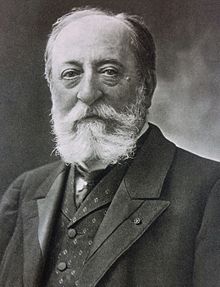
"ERCOLE E DEIANIRA" is an "tragedia lirca" in 4 acts composed by Camille Saint-Saëns to a libretto by Louis Gallet and Camille Saint-Saëns.
The last of Saint-Saëns' operas, "ERCOLE E DEIANIRA" premiered on 14 March 1911 at the Théâtre de Monte-Carlo.
One of the opera's central characters, ERCOLE, had been the subject of two earlier symphonic poems by Saint-Saëns – Le Rouet d'Omphale (1872) and La Jeunesse d'Hercule (1877).
The story is based on The Trachiniae by SOFOCLE (also the source for Handel's opera ERCOLE).
ERCOLE E DEIANIRA began its life in 1898 as a play with accompanying symphonic music, choruses and a ballet.
Fernand Castelbon de Beauxhostes, one of the owners of a newly constructed arena in Béziers (used primarily for staging bullfights), wanted to make Béziers a centre for the performance of open-air opera as well.
He persuaded Saint-Saëns to write the score for a performance of Louis Gallet's epic verse-drama Déjanire to inaugurate the project.
At first Saint-Saëns was reluctant to have his music performed in what he called an "abominable temple of blood".
However, Castelbon managed to convince him by inviting him to visit the arena where his arrival was greeted by hidden musicians playing in his honour.
In August 1898 ERCOLE E DEIANIRA opened in Béziers with two performances before 12,000 spectators each time.
The reception was ecstatic with Saint-Saëns conducting a huge musical ensemble consisting of a choir of hundreds, massed military bands and an orchestra that included 18 harps and an array of 25 trumpets.
Although fatally ill and suffering from deafness, Louis Gallet managed to attend the second performance. In his memoirs Saint-Saëns recalled:
In spite of everything, including his ill health which made the trip very painful, he wanted to see his work once more. He heard nothing, however – neither the artists, the choruses, nor even the applause of the several thousand spectators who encored it enthusiastically. A little later he passed on, leaving in his friends' hearts and at the work-tables of his collaborators a void which it is impossible to fill."[5]
Twelve years later, Saint-Saëns transformed Gallet's play into a fully-fledged opera to fulfill a commission from the Opéra de Monte-Carlo. Gabriel Fauré was in the audience for its world premiere on 14 March 1911, conducted by Léon Jehin and directed by Raoul Gunsbourg.
Following the Monte Carlo premiere, the work was performed at the Paris Opera on 22 November 1911. (The Paris premiere caused a minor scandal when Mlle. Delsaux danced the ballet segment with bare legs and clad only in "flimsy draperies" instead of the traditional bell-shaped skirt.)[7]
The first performance of Déjanire in the United States came on 9 December 1915 when it was presented by the Chicago Opera Association with Carmen Melis and Lucien Muratore in the leading roles.[8] Although very rarely performed today, Déjanire was revived at the Festival de Radio France et Montpellier in a 1985 performance conducted by Serge Baudo.
| Role | Voice type | Premiere Cast, 14 March 1911 (Conductor: Léon Jehin) |
|---|---|---|
| Déjanire (Deianira) | soprano | Félia Litvinne |
| Iole | soprano | Yvonne Dubel |
| Phénice | contralto | Germaine Bailac |
| Hercule (Hercules) | tenor | Lucien Muratore |
| Philoctète (Philoctetes) | baritone | Henri Dangès |
| The people of Oechalia and Trachis (chorus) | ||
Synopsis
- Place: Trachis
- Time: Ancient Greece
The tenor aria,
"Viens, O toi dont le clair visage", from ERCOLE E DEIANIRA can be heard on Antonio Paoli – "Il Mito Dell'opera" (Bongiovanni #1117).
References:
- Notes

Deianera by Evelyn De Morgan
- ^ Jump up to: a b Hugh Macdonald: "Déjanire ", Grove Music Online ed. L. Macy (Accessed 2 March 2009), (subscription access)
- Jump up ^ Original French: "le temple abominable du sang", quoted in Molénat (10 August 2000)
- Jump up ^ Festival de Radio France et Montpellier
- Jump up ^ Rees (22 February 1999)
- Jump up ^ Saint-Saëns (1919)
- Jump up ^ Casaglia
- Jump up ^ New York Times (17 December 1911)
- Jump up ^ Lahee (1922)
- Jump up ^ This synopsis is based on Gelli (2007)
- Sources
- Casaglia, Gherardo, 14 November 1911, Almanacco Amadeus. Accessed 24 February 2009.
- Festival de Radio France et Montpellier, Camille Saint-Saëns: Déjanire, 9 July 1985. Accessed 24 February 2009.
- Gelli, Piero (ed.), "Déjanire" in Dizionario dell'Opera, Baldini Castoldi Dalai, 2007, ISBN 88-6073-184-4. Accessed online 27 February 2009.
- Lahee, Henry Charles, Annals of Music in America, Marshall Jones Co., 1922. Accessed 24 February 2009.
- Macdonald, Hugh, "Déjanire", Grove Music Online ed. L. Macy (Accessed 24 February 2009), (subscription access).
- Molénat, Jacques, La movida de Béziers, L'Express, 10 August 2000. Accessed 24 February 2009.
- New York Times, Dances Shocked Paris; Flimsy Draperies Now Barred, 17 December 1911. Accessed 24 February 2009.
- Rees, Brian, A proposal: Saint-Saens - the movie, The Independent, 22 February 1999. Accessed 24 February 2009.
- Saint-Saëns, Camille, Musical Memories (in English translation by Edwin Gile Rich), Small, Maynard & Co., 1919. Accessed 24 February 2009.
| ||








No comments:
Post a Comment